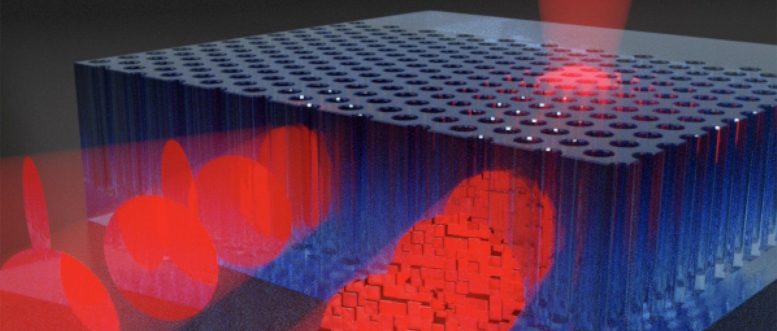
Light that is sent into a ‘photonic crystal’, can’t go deeper than the so-called Bragg length. Deeper inside the crystal, light of a certain color range can simply not exist. Still, researchers of the University of Twente, the University of Iowa, and the University of Copenhagen managed to ‘break’ this law. They steer light into a crystal, using a programmed pattern, and demonstrate that it will reach places far beyond the Bragg length. They publish their findings in Physical Review Letters.
Photonic crystals have a regular pattern of nano pores etched in silicon. They are typically designed to work as a mirror for a certain color range of light. Inside the crystal, light of those colors is ‘forbidden.’ Even if you’d be able to place an atom inside the crystal, that typically emits one color, it will stop emitting light. The so-called Bragg length is the maximum distance light is allowed to travel, according to a well-known physics law.
This property can be used for creating perfect mirrors for certain wavelengths, but it also helps improving solar cells. Still, if there is a sign that says ‘forbidden’ anywhere, then it is always tempting to go there. This is what the researchers did, they proved that light can penetrate the photonic crystal, much deeper than the Bragg length.
Bright spot at five times the Bragg length
They managed to do this by using light that was pre-programmed, and by using the small imperfections that always come with creating nanostructures. These imperfections cause light waves to be scattered randomly inside the crystal. The researchers program the light in such a way that every location inside the photonic crystal can be reached. They even demonstrate a bright spot at five times the Bragg length, where light is enhanced 100 times instead of decreased 100 to 1000 times.
Stable qubits
This remarkable result can be used for creating stable quantum bits, for a light-driven quantum computer. The ‘forbidden effect’ can also be employed in miniature on-chip light sources and lasers.
The research was done in the Complex Photonics group of Professor Willem Vos. The group is part of UT’s MESA+ Institute. The first author, Ravitej Uppu, who worked in this group earlier on, is now a Professor at the University of Iowa. The research collaboration was continued, also together with the University of Copenhagen. It was supported by Dutch Research Council (NWO) programs ‘Stirring of Light’, ‘Free form scattering optics’ and ‘Self-assembled icosahedral quasicrystals with a band gap for visible light’, by the Applied Nanophotonics section of the MESA+ Institute and the Center for Hybrid Quantum Networks of the Niels Bohr Institute in Copenhagen.
Reference: “Spatially Shaping Waves to Penetrate Deep inside a Forbidden Gap” by Ravitej Uppu, Manashee Adhikary, Cornelis A. M. Harteveld and Willem L. Vos, 27 April 2021, Physical Review Letters.
DOI: 10.1103/PhysRevLett.126.177402
3 Comments
… yo, how does go there, … do we need a priest?
The ñumeŕical figures of the results of mòdified Bragg length fòr
maximùm distance light tŕavels fòrtypical wavelength is còmprehensìve and perfect.The theòry ŕèĺating fòrbidden waveĺèngþh of light byan atom ìn a crýstal and thèn buildìng nanòçrystal wìth ìmperfèction in order to enhance lìght ußed of certaìn wavèlèngth while reflècts randomly,is good.
… bring the priest in…